Artnet News Pro
Beyond Amoako Boafo: The Next Emerging Names You Need to Know in Accra, Ghana’s Rapidly Accelerating Art Hub
The vibrant art scene that birthed breakout stars Amoako Boafo and Ibrahim Mahama has plenty more in store.
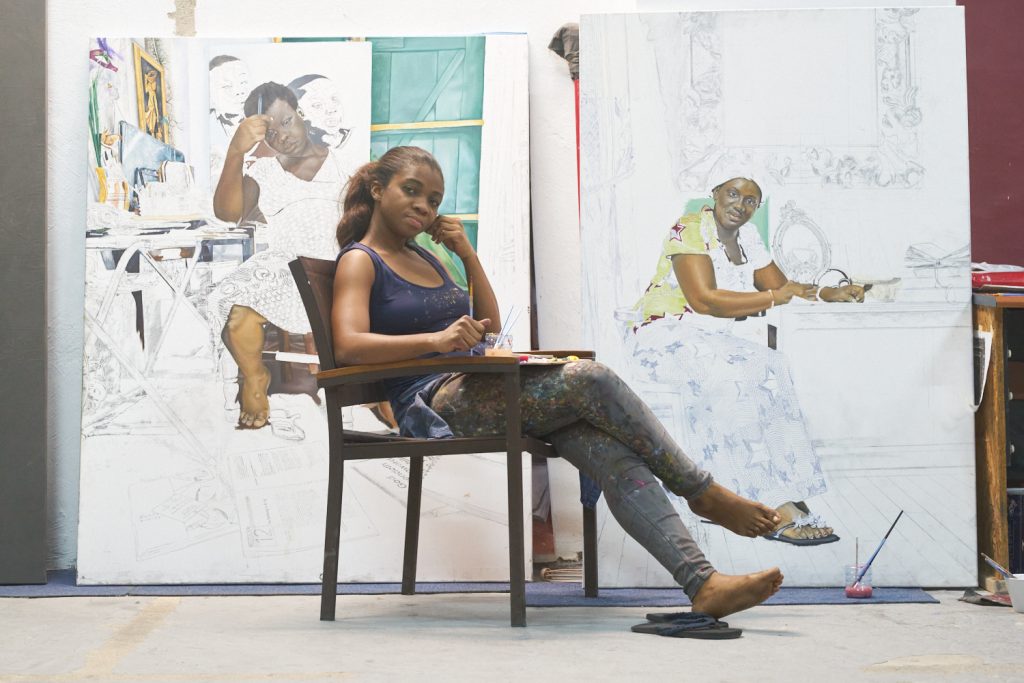
The vibrant art scene that birthed breakout stars Amoako Boafo and Ibrahim Mahama has plenty more in store.

Rebecca Anne Proctor

All eyes are on Accra, the capital of the small West African nation of Ghana, where a vibrant art scene is on the rise. Quickly becoming one of the African continent’s main hubs for contemporary art, the equatorial port city now hosts a growing generation of young artists, many inspired by the global success of the country’s biggest stars, such as Amoako Boafo and Ibrahim Mahama. Most of these rising stars work in portraiture and large abstract figurative paintings, portraying the powerful faces and figures of West African men and women, some easily identifiable while others are anonymous persons taken from magazine clippings or Instagram. Here, we scout out seven of the most-sought after emerging artists working in Accra today.
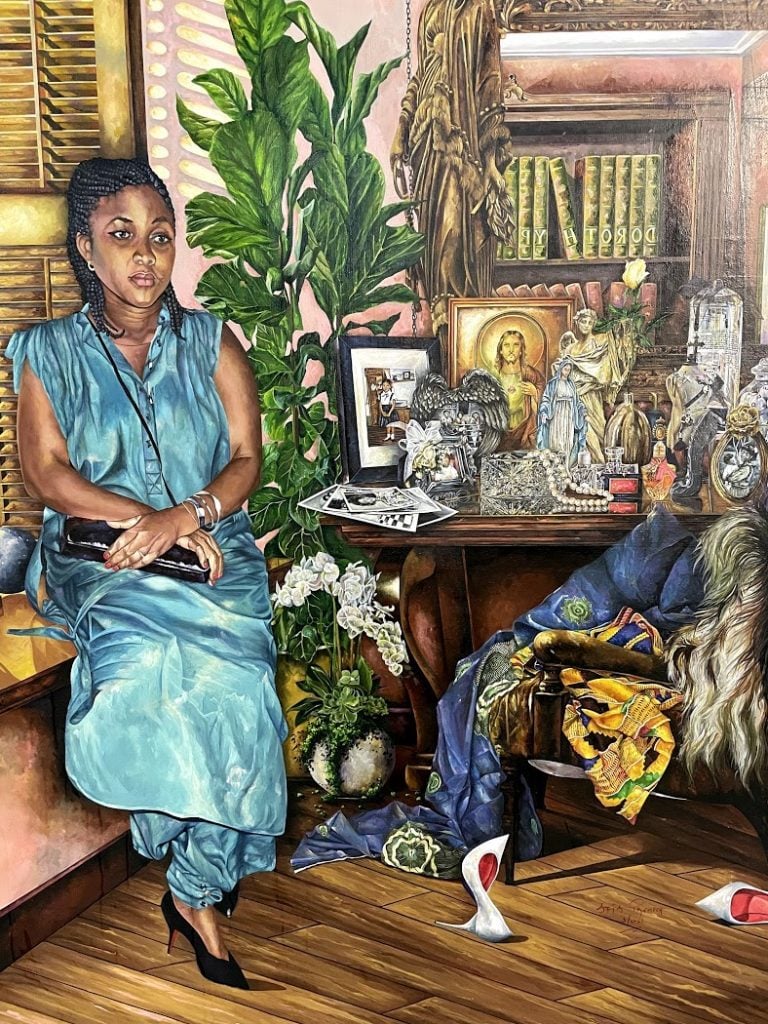
Afia Prempeh, Dorothy (2021). Photo by Nii Odzenma, courtesy Gallery 1957.
Affiliated with: Gallery 1957
Most wanted: Empathic portraits of women
Price range: $6,000–20,000
Born in Kumasi, Ghana, Afia Prempeh centers her practice on contemporary social-realistic portrayals of Ghanaian women. Educated at the prestigious Kwame Nkrumah University of Science and Technology in Kumasi, Prempeh began her career as a landscape artist and now focuses on portraiture. Her works superimpose subjects painted from photographs against surrounding she imagines in her mind. Each work focuses steadily on the sitter at hand—usually a female figure close to her, such as her mother or a close friend or relative, while in other works she turns her attention to young Ghanaian women and the social issues they face. One untitled work completed in 2021, depicts a young woman trying to study and work as she grapples with an unexpected pregnancy—a phenomenon Prempeh says “occurs often in Ghana and makes it difficult for women to finish their education.” The artist is presently finishing a residency with Gallery 1957 and preparing for her first solo exhibition set to run from early November.
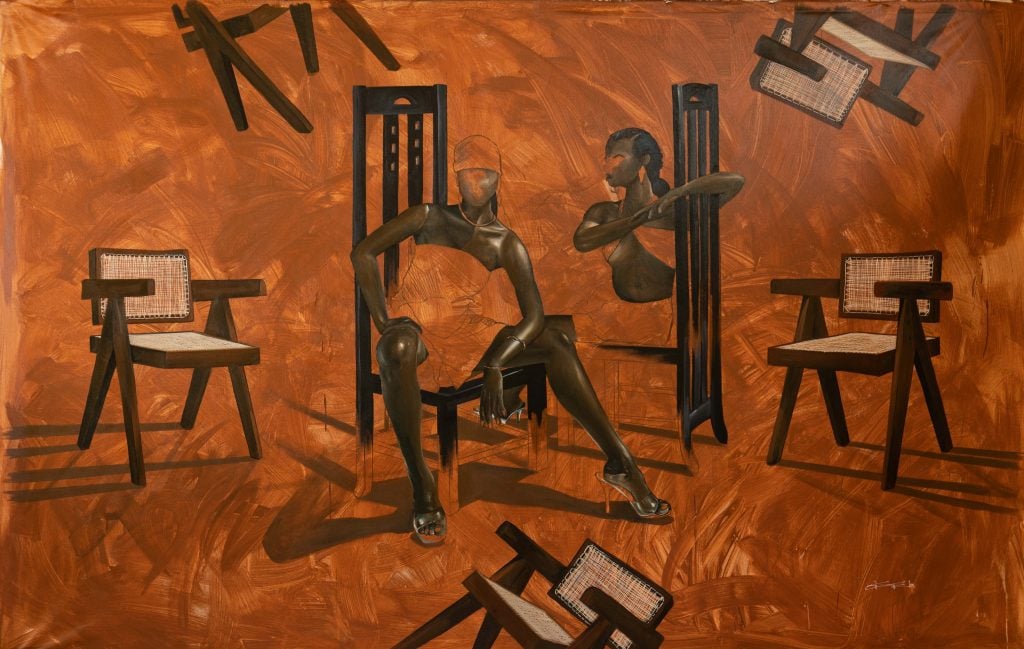
Joshua Oheneba-Takyi, The Future is Female (2021). Courtesy of Gallery 1957, Accra.
An entirely self-taught artist, as a young boy Joshua Oheneba-Takyi was always drawing and painting. Born in Kumasi, after he studied building technology at Kwame Nkrumah University of Science and Technology, he decided to dedicate himself to his art. Today his practice consists of large-scale canvases in saturated acrylics with an instantly recognizable signature element: chairs, from generic plastic models to modernist icons. Strewn in various positions and laden with figures in a variety of poses, it is the chairs, more so than the people, that command attention. Rather, with their blurred, unfinished facial features, the characters are communicated by how each interacts with the chairs. Oheneba-Takyi says he wants to showcase the universality of the chair and how this mundane, inanimate object is conditioned by its own unique history— the various places where it has been placed, the people who have used it and where the chair is placed now. The artist is a 2021 Junior Fellow at the Noldor Residency in Accra and just had his first solo exhibition at Gallery 1957, fittingly titled “A Seat at the Table.”
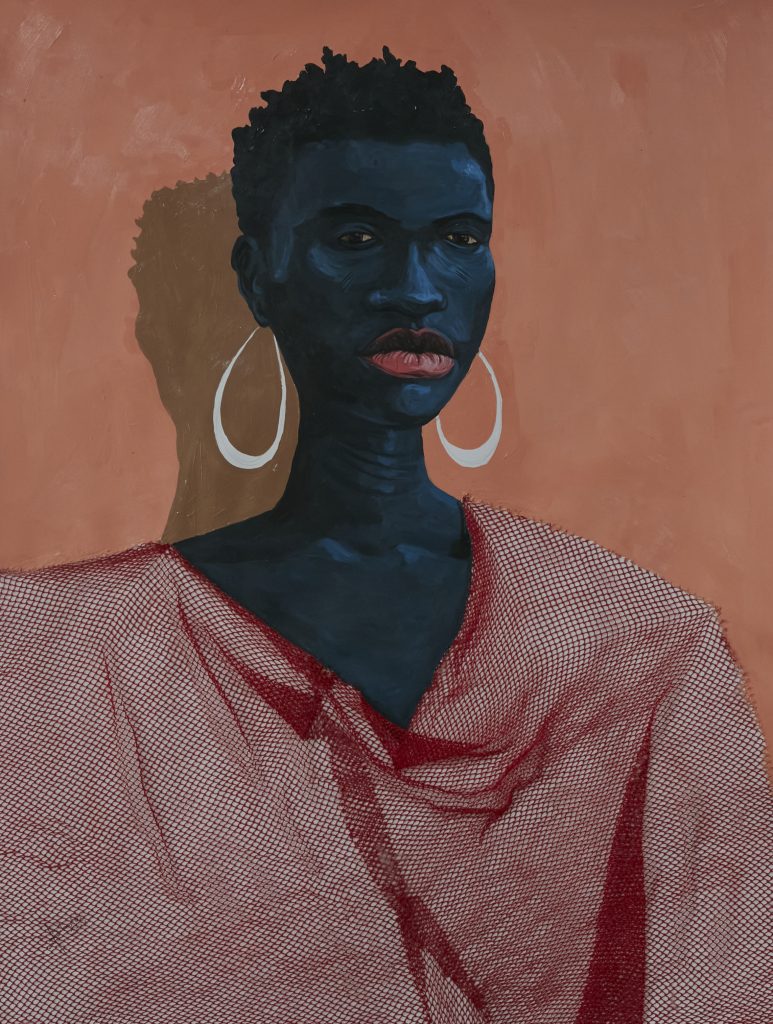
Eric Adjei Tawiah, Red on Black (2021). Courtesy of Gallery 1957, Accra.
Eric Adjei Tawiah has garnered buzz for his emotive paintings that incorporate what he calls “sponge material,” or pieces from colorful mesh body sponges to his canvases. The approach was inspired by his experience of watching his mother’s body being cleansed in a mortuary—and in many ways, his vibrant, figurative portraits offer a metaphorical way to cleanse negative thoughts. Tawiah works from his space at a studio owned by Boafo, a place where several artists, with permission from Boafo, are given free workspace to create their art. There he enhances his evocative renderings of Ghanaian men and women with flat, vivid backdrops and incorporates his mesh sponge material. Sometimes his subjects are locked in an emotional embrace, other times they stare directly out to the viewer, as if in longing or silent determination. Tawiah trained at the acclaimed Ghanatta College of Art and Design. His work was recently featured in Gallery 1957’s dual show “Could You Be Loved,” with fellow artist and studiomate Aplerh-Doku Borlabi.
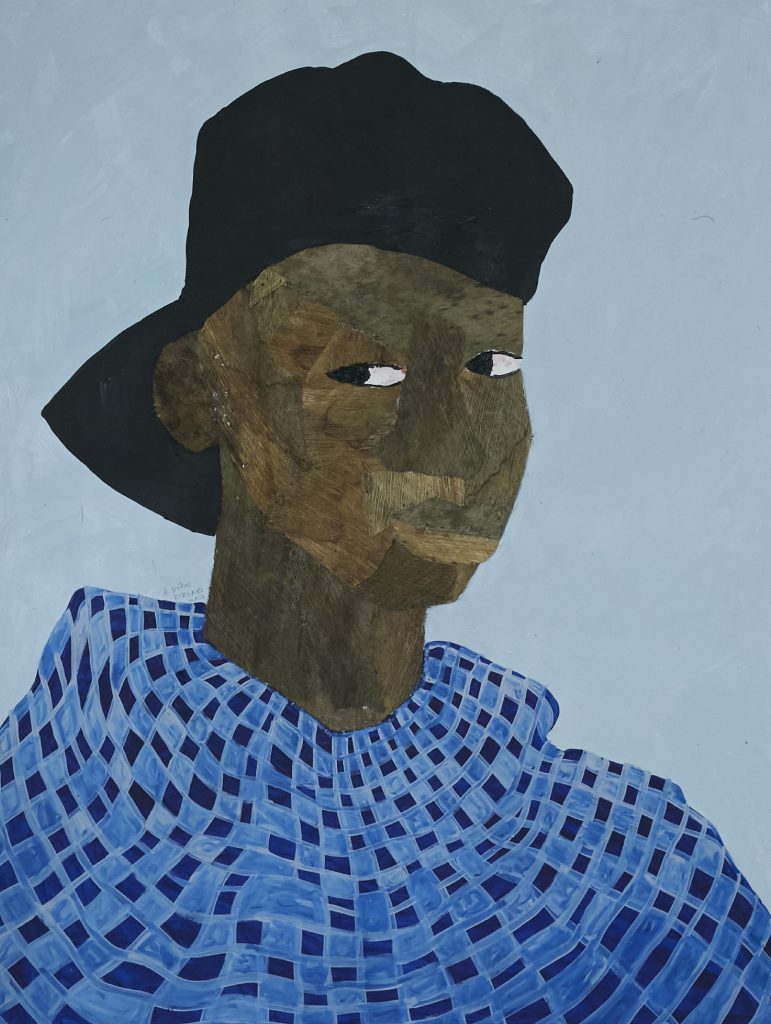
David Aplerh-Doku Borlabi, Black Cap (2021). Courtesy Gallery 1957, Accra.
Affiliated with: Gallery 1957
Most wanted: Coconut tree-bark paintings
Price range: $6,000–30,000
The large-scale paintings of Ghanaian artist Aplerh-Doku Borlabi (who, like Tawiah, also practices in the studio space of Amoako Boafo), incorporate bark from the coconut tree. Growing up in the CoCo Beach area of Accra, the tree and its fruit were part of the artist’s daily routine. His abstract renditions of African men and women merge the skin from coconut trees into their painted figures, oftentimes with golden embellishments. Borlabi has used densely layered coconut bark, for example, to render the skin and bone texture of his subjects. He notes that the coconut skin also serves as a metaphorical statement to refer to what is discarded, considered unattractive compared to what is natural. Borlabi’s joyful works ultimately serve to elevate the specific and local, as well as celebrate African people globally.
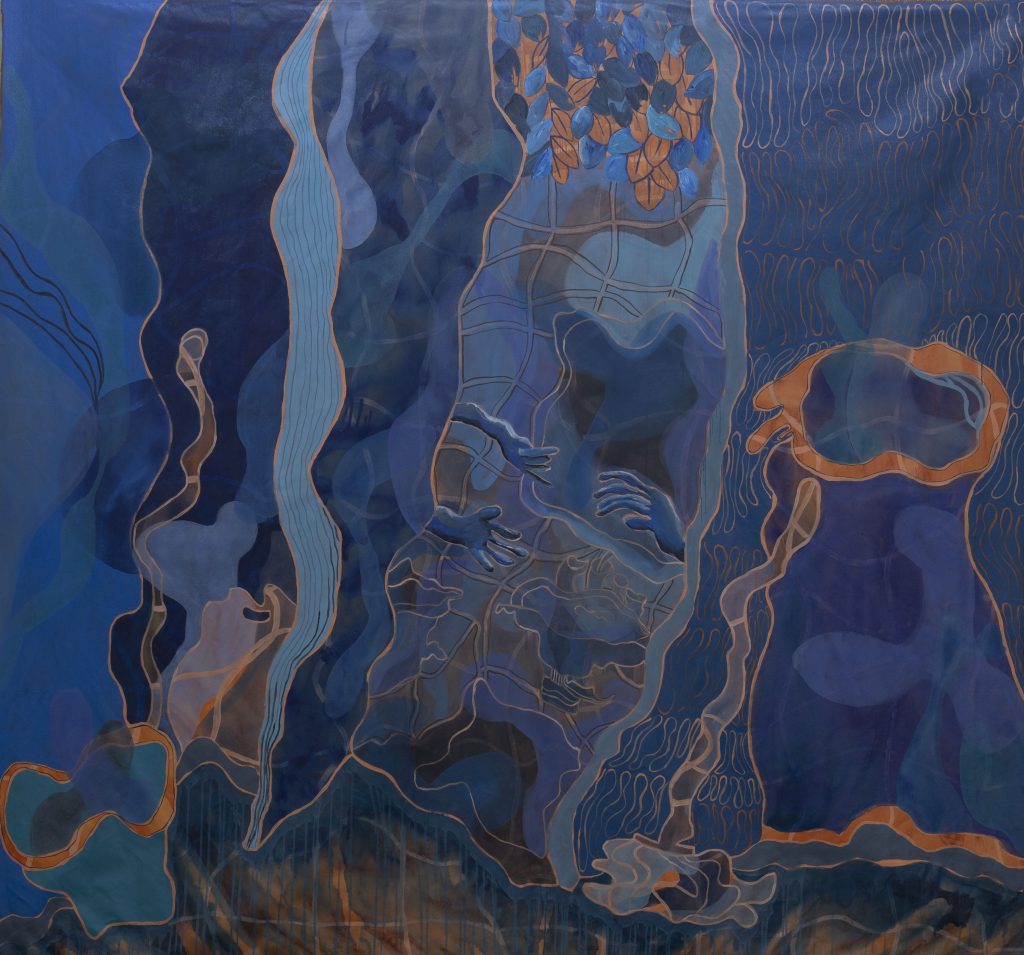
Araba Opoku, Jubilee Well Street (Layered Consciousness) (2021). Courtesy of the artist and Gallery 1957 and ADA \ Contemporary.
Affiliated with: Gallery 1957 and ADA \ Contemporary
Most wanted: Lyrical, layered abstractions
Price range: $5,000–15,000
Araba Opoku takes a textile-like approach to painting, whereby various colors and forms from the world around her merge on her canvases in patchwork creations. The principal subject of Opoku’s current work is widespread water shortages in Ghana, or “water rationing,” as she calls it. “These works are autobiographical in the sense that I experience water shortages,” she told Artnet News. Opoku lives with her mother and her sister in an area subject to frequent water shut-offs. “From morning until evening the taps are closed. We wake up at 12 a.m. and fetch water. If you have used your water for the week, then you have to go outside and get more water,” she explained. Several of her metaphysically-tinged abstractions suggest the ebb and flow of water as she recreates on canvas the element that she and so many of her neighbors lack. Opoku will be a Junior Fellow at the Noldor Residency in 2022. In August, she was recently the recipient of the inaugural Yaa Asantewaa Art Prize for Women by Gallery 1957.
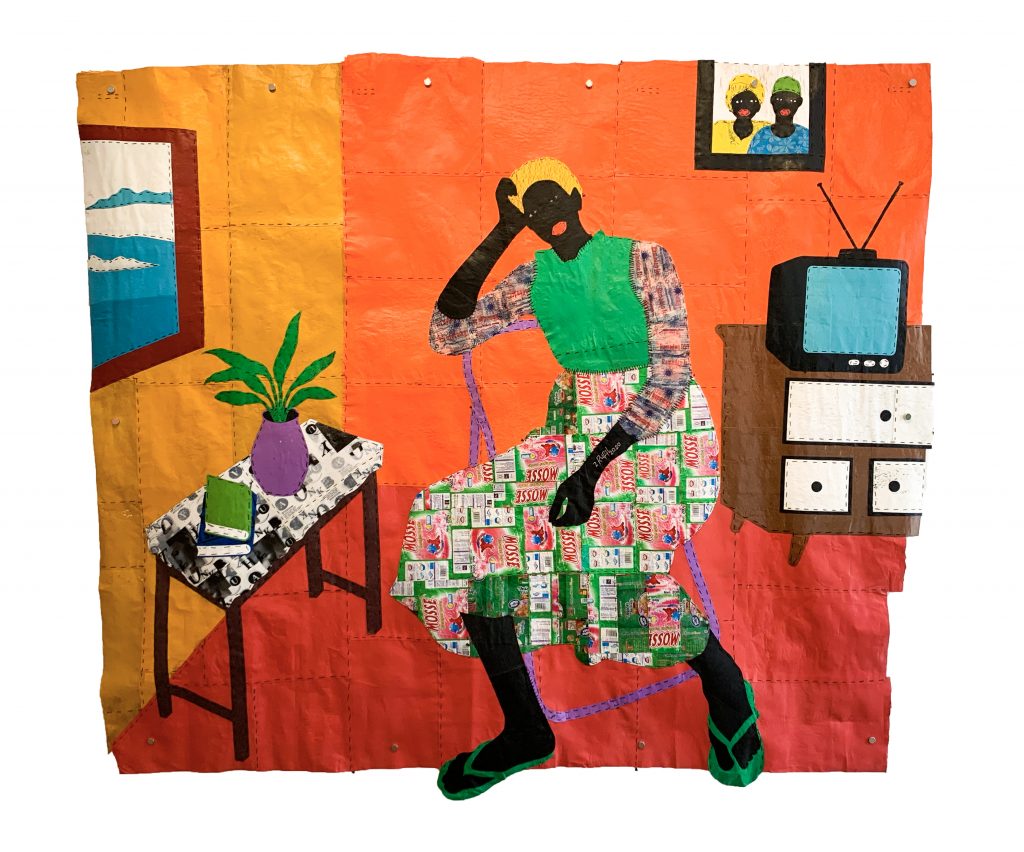
Rufai Zakari, “Wasila” The Lone Girl, 2021. Courtesy of Kristin Hjellegjerde Gallery, London and Berlin.
Rufai Zakari explores themes of environmental pollution, consumerism, labor, and trade in his varied oeuvre. His vibrant figurative works, highlighting lively portraits of Ghanaian men and women dressed in traditional or contemporary garb as they go about their day, are made from discarded single-use plastics gathered around Ghana. Born in 1990, he graduated from the Ghanatta College of Art and Design. Dedicated to recycling street waste and creating uplifting and thought-provoking works of art from used plastics, Zakari likes to look into the future. He splits his time between Accra and his native Bawku, hoping to instill into his hometown—which was torn apart after decades of tribal conflict—a sense of optimism and growth.
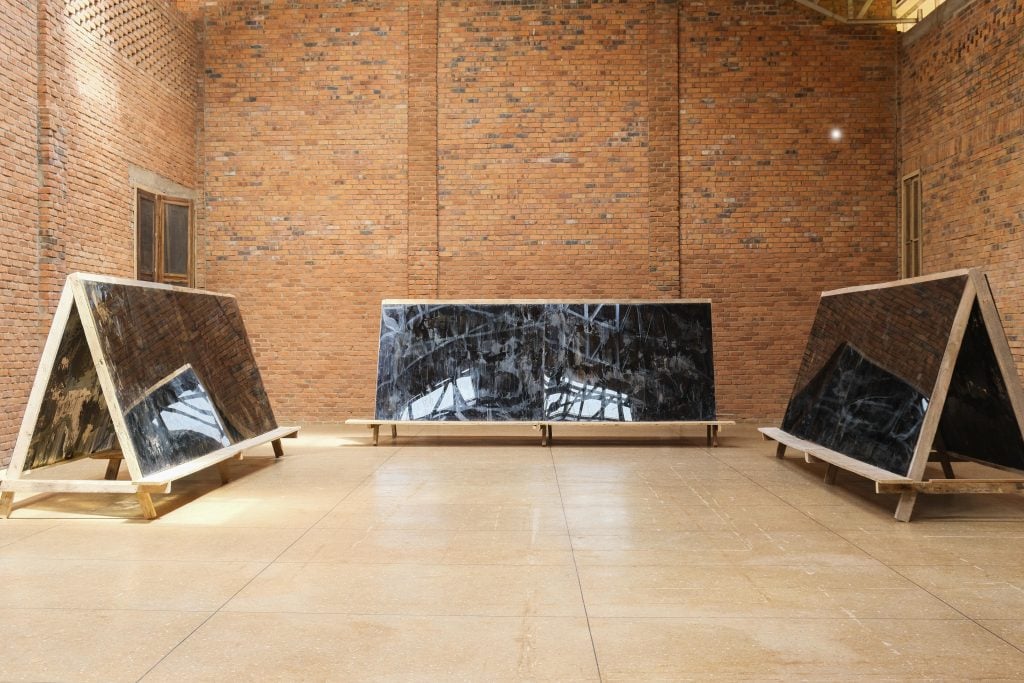
Eric Gyamfi, Trade winds and shadow objects; north by southeast (2021), installed at Red Clay Studio in Tamale.
Eric Gyamfi is a photographer known for his exploration of Ghanaian social life. His startling black-and-white images—which have been exhibited at Rencontres De Bamako and LagosPhoto, as well as profiled in Aperture and the New York Times—captivate the viewer with ease and power. Lately, he has turned his lens to the country’s weather and native plants. Gyamfi is currently exhibiting at Ibrahim Mahama’s Red Clay Studio space in the northern city of Tamale, as part of the group show “A Diagnosis of Time: Unlearn What You Have Learned.” The title of Gyamfi’s piece, Trade winds and shadow objects; north by southeast (2021), nods to the materials that were used to make it. The installation comprises triangular structures supported by wooden frames, onto which he places photographic plates made from glass, neem, teak, and shea pigments, all suspended in gelatins, potassium ferrocyanide and ferric ammonium citrate. The concept of “trade winds” reflects on the socio-political and economic mechanisms that continue to influence the movement of indigenous plants around the world.